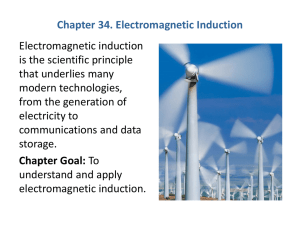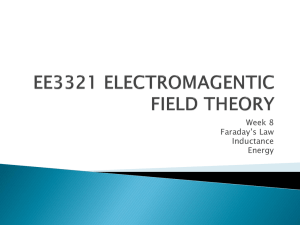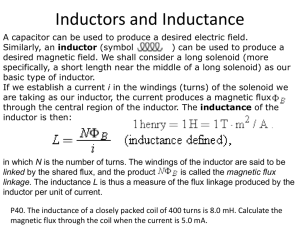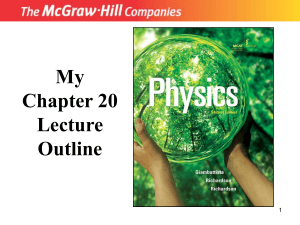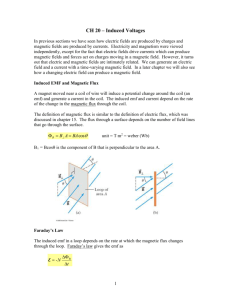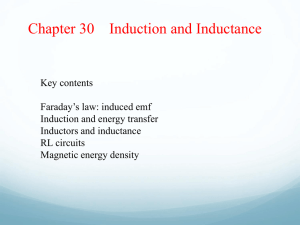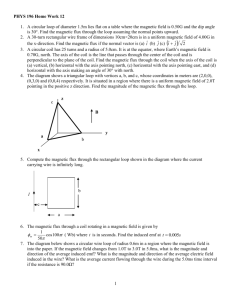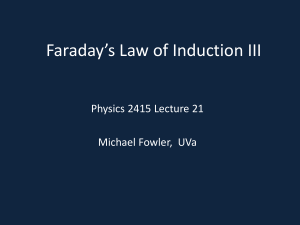Induction and Inductance
advertisement
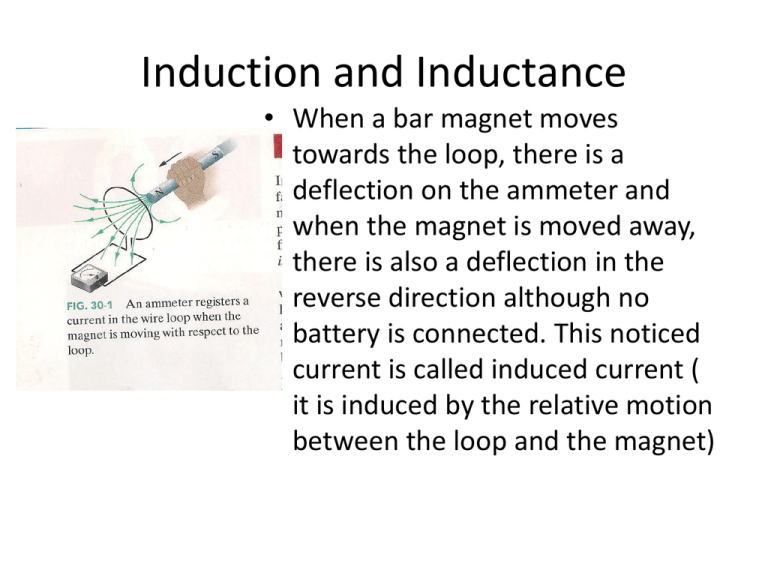
Induction and Inductance • When a bar magnet moves towards the loop, there is a deflection on the ammeter and when the magnet is moved away, there is also a deflection in the reverse direction although no battery is connected. This noticed current is called induced current ( it is induced by the relative motion between the loop and the magnet) The work done per unit charge to produce(induce) this current is called induced current. An emf is induced in the loop when the number of magnetic field lines that pass through the loop is changing. We therefore define the magnetic flux density through the loop as If the magnetic field is perpendicular to the plane of the loop then we can write And if the magnetic field is uniform then The unit of magnetic flux is tesla-square meter called Weber(Wb) Faraday’s law of induction The magnitude of the emf ε induced in a conducting loop is equal to the rate at which the magnetic flux , through that loop changes with time Faraday’s law The –ve sign only indicates that the emf usually opposes the magnetic flux change. If the loop comprises of a coil of N turns then Note that the magnetic flux through a coil depends on The magnitude B of the magnetic field within the coil The total area of the coil or the portion that lies within the magnetic field The angle between the direction of the magnetic field and the plane of the coil The flux through each turn of coil depends on the area A and orientation of that turn in the solenoid’s magnetic field . Because is uniform and directed perpendicular to area A. The magnitude B of the magnetic field in the interior of a solenoid’s current i and its number n turns per unit length LENZ’S LAW • Heinrich Friedrich lenz devised a rule for determining the direction of an induced current in a loop. • An induced current has a direction such that the magnetic field due to the current opposes the change in the magnetic flux that induces the current INDUCED ELECTRIC FIELD An emf is induced by a changing magnetic flux even if the loop through which the flux is changing is not a physical conductor but an imaginary line. The changing magnetic field induces an electric field E at every point of such a loop. The induced emf is related to by Where the integraton is taken around the loop. In most general form, Faraday’s law can be written as a changing magnetic field induces an electric field INDUCTORS AND INDUCTANCE • Just as capacitors can be used to produce electric field, an inductor can be used to produce a desired magnetic field. • The inductance of an inductor is given as (Tesla sq meter per Ampere) where N=no of turns, i= current in the windings. • The product = magnetic flux leakage Hence Inductance per unit length is given by inductance thus depends only on the geometry of the devise. SELF INDUCTANCE • When two coils (inductors) are beside each other, a current I in one coil produces a magnetic flux through the second coil. If we change this flux by changing the current, an induced emf appears in the second coil according to Faraday’s law. • “an induced emf εL appears in any coil in which the current is changing” • From these eqns ( ) we have (self induced emf) in any inductor (coil,solenoid or a toroid) a self induced emf appears whenever the current changes with time. RL circuit i x y z * (RL circuit eqn) • For a circuit containing resistor, inductor and emf source, the loop rule is applied. • From x to y in the directon of current, there is a voltage drop across R is • From y to z, there is a self induced emf across the inductor given by ( the direction opposes the loop current) There is a potential difference of due to the emf source From the loop rule The solution to eqn * when i(0) =0 is where • When the emf source is removed, current I does not suddenly goes to zero. • Setting the RL circuit eqn to zero we have • The solution which satisfies the initial condition is decay current ENERGY STORED IN A MAGNETIC FIELD • From the RL circuit eqn • Multiplying by i we have 1st term represents the rate at which the emf devise delivers energy to the rest of the circuit 3rd term i2R is the rate at which energy appears as thermal energy in the resistor 2nd term rep the energy that does not appear as thermal energy which implies it is stored in the magnetic field of the inductor. rate at which energy is stored up in the magnetic field of the inductor and Sample problem In the figure below, R1=8 Ω, R2= Solution 10Ω, L1=0.3 H, L2=0.2 H and Just when the circuit is connected, the ideal battery has ε=6V (a) t-0, no current flows through the just after switch S is closed, inductor and also through the at what rate is the current in resistor so that equation of LR inductor changing? (b) When circuit becomes the circuit is in steady state, what is the current in inductor 1? When the circuit is in steady state, inductors L1 and L2 just act connecting wire. If we neglect the resistivity of the wires, then no current passes through R2 such that Sample problem • A coil is connected in series with a 10Kilo-ohm resistor, an ideal 50 V battery is applied across the two devices, and the current reaches a value of 2mA after 5 ms. (a) find the inductance of the coil. (b) How much energy is stored in the coil at this moment?

